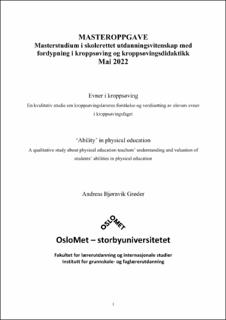| dc.description.abstract | Denne undersøkelsen retter seg mot kroppsøvingslæreres forståelse og verdisetting av elevers evner i kroppsøvingsfaget med problemstillingen: Hvilken forståelse har et utvalg kroppsøvingslærere av elevers evner i forbindelse med kroppsøving, og hvilke evner hos elever verdsetter disse lærerne? Gjennom min studie har jeg intervjuet fem kroppsøvingslærere, tre mannlige og to kvinnelige, fra fire forskjellige ungdomsskoler i Oslo-området. Alle deltakerne i undersøkelsen har formell kompetanse og underviser i kroppsøving på ungdomstrinnet. Oppgaven baserer seg på en sosiokulturell metodisk tilnærming med kvalitativt intervju som datainnsamlingsmetode. Oppgaven bruker Pierre Bourdieus teorier om habitus, kapital, felt og doxa som teoretisk fortolkningsramme. Disse teoriene har blitt brukt for å komme nærmere en forståelse av evner i kroppsøvingsfaget i et sosiokulturelt perspektiv. John Evans sitt arbeid med evner i kroppsøvingsfaget er også en del av det teoretiske grunnlaget, som har blitt brukt for å bryte opp, definere og diskutere fenomenet, også i tilknytning til Bourdieus teorier. På bakgrunn av det analyserte datamaterialet, vokste det frem to strukturelle overskrifter med tre kategorier til hver del, som fremstår som hovedfunnene i oppgaven. Den første delen tar for seg deltakernes beskrivelser av fenomenet evner gjennom kjente ord knyttet til kroppsøving. Den andre delen tar for seg deltakernes beskrivelser av elevers evner i forbindelse med kroppsøving. Gjennom diskusjonspunkter som omhandler en sosiokulturell forståelse av elevers evner og verdisettingskultur, konkluderer studien med at ungdomsskolelærere forstår evner ulikt. Innsats, ferdighet og forutsetninger er ord som blir brukt av deltakerne for å beskrive fenomenet evner knyttet til kroppsøving. I tillegg til dette, fremstår idrettsbakgrunn og talent som avgjørende elementer i defineringen av hvilke elever som er ‘able’ og hvilke elever som er ‘less able’ gjennom en verdisettingskultur som har en tendens til å harmonere kun med en viss type bevegelseshabitus. Til slutt viser denne studien at fysiske egenskaper legger føringer for elevers evner, som videre må ses i lys av elevenes forutsetninger i kroppsøvingsfaget.
This study focuses on the perceptions and valuation of physical education teachers regarding their pupils’ abilities in physical education, addressing the thesis question: What perceptions do a selection of physical education teachers have of their pupils’ abilities in physical education, and what types of abilities in these pupils do these teachers value? For this study, I interviewed five physical education teachers, three male and two female, from four different lower secondary schools in the Oslo region. All survey participants possess formal teaching qualifications and teach physical education at the lower secondary level. The study is based on a socio-cultural methodological approach with qualitative interviews as the data collection method. Pierre Bourdieu's theories of habitus, capital, field and doxa provide the theoretical interpretive framework for this study. These theories are used to gain a better understanding of the notion of ability in physical education from a sociocultural perspective. John Evans’ work on ability in physical education also contributes to the theoretical basis of the study, and is used to categorize, define and discuss the phenomenon in connection with Bourdieu's theories. Based on the data analyzed, two structural categories with three sub-categories each emerged. These categories comprise the main findings of the study. The first main category concerns participant descriptions of the phenomenon abilities using key physical education terminology. The second category deals with participant descriptions of their pupils’ physical education abilities. Through discussion with participants on their socio-cultural understanding of pupils’ abilities and cultural values, the study concludes that lower secondary school teachers understand ability differently. Effort, skill and preconditions are terms the participants use to describe the phenomenon abilities in relation to physical education. In addition to this, participation in organized sports and talent appear as crucial elements in participants’ identification of pupils they consider ‘able’ and those they consider ‘less able,’ based on cultural values that tend to reward only certain types of movement habitus. Finally, this study shows that the physical attributes of pupils contribute to their abilities, which must also be seen in the light of pupils’ preconditions for physical education. | en_US |
